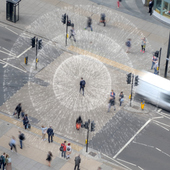Open Letter
For selective confinement assisted by digital tracing
In the absence of a vaccine against Covid19 and treatments to cure this disease, we had to temporarily accept the systematic confinement of the population with the aim of slowing the spread of the epidemic and avoid the saturation of our healthcare system. This could only be achieved at the cost of our freedom of movement, the functioning of the economy, our material and psychological well-being and the quality of education received by our children.
In order to put an end to this confinement without triggering a resurgence of the epidemic and risking a new confinement, we must be able to identify as quickly as possible and warn all “contact persons” at high risk of having been contaminated so that they can take all the required measures as part of the TEST-, TRACK-, ISOLATE-process. Indeed, these persons at risk may have had contact with infected persons who did not present any symptoms at the time and who were subsequently tested positive. It will thus be possible to stop these contact cases from spreading the virus to other individuals by encouraging them to isolate themselves and, if needed, to quickly provide them with the appropriate care they require. Such tracking allows for intelligent selective confinement. Virological testing should be offered to contact persons taking into account the time required for the virus to be detectable in the nasopharynx after contamination (approximately 7 days after the potentially infecting contact). While waiting for the result of the virological screening test, they must be asked to wear a mask, accompanied by the strictest respect for barrier gestures and a drastic reduction in the number of contacts, who, in turn, must also be traced afterwards.
In order to cover a very large part of the population by ensuring the fastest possible feedback to contact cases, the scale of a classic TEST, TRACE, ISOLATE process to be implemented is considerable. A very large number of investigative brigades are required, each investigation can take a long time and will leave out anonymous contact cases encountered in public places. In this context, the digital tracing process aims to automate manual tracing operations as much as possible in order to reduce the number of investigators, shorten the duration of investigations and improve their efficiency. It complements and does not replace manual tracing, nor does it use the information system.
The technical principles of a digital tracing application
Without going into detail about the methods used, tracing solutions are based on three operations:
Detection of an encounter: currently it is Bluetooth protocol that is being considered, to allow two mobile phones less than ten meters apart to identify and converse with each other (in some countries it is the GPS technique that is used to pick up encounters).
Exchange during an encounter: Each phone issues an identifier (anonymous, not linked to its mobile number and which it can change regularly) and records all the identifiers it receives.
Back-propagation of risks: when an individual is contaminated, the tracing system can warn people with whom it has been in contact without revealing their identity.
In addition, thanks to the database, epidemiologists can get a global view of the progress of the pandemic (e.g. early identification of clusters), based on anonymous individual information.
The limitations of a digital tracing protocol
Even if the protocol guarantees the security of the data and the anonymity of the people who alert about the fact that they have been tested positive, it is possible to imagine risks of malicious use or misappropriation (https://risques-tracage.fr/). Persons encouraged to install a tracing application must have been duly informed of the risks that the chosen system cannot completely eliminate and of the possibility of disabling the application when they wish to do so.
Enabling everyone to participate in the fight against the pandemic
By using the application, everyone can actively contribute to stopping the epidemic, providing data to the scientists who analyse it and of course protecting themselves and their loved ones.
Organising trust
In order to increase citizens’ support for the use of a tracing application, it is important to specify that the duty of medical confidentiality as practised by health professionals will be extended to anyone who may have access to the digital data collected. Furthermore, it is the State that will be responsible for ensuring the application’s 24/7 operation and the security of the platform, as it already successfully does for other digital platforms (taxes, health hub, social security card, etc.) through bodies that have demonstrated their ability to ensure the protection of individual data.
Signatories:
Patrick Couvreur, President of the French Academy of Pharmacy
Bruno Jarry, Honorary President of the National Academy of Technologies of France
Liliane Keros, Permanent Secretary of the French Academy of Pharmacy
Gerard Roucairol, Honorary President of the National Academy of Technologies of France
Sébastien Candel, Member of the National Academy of Technologies of France

